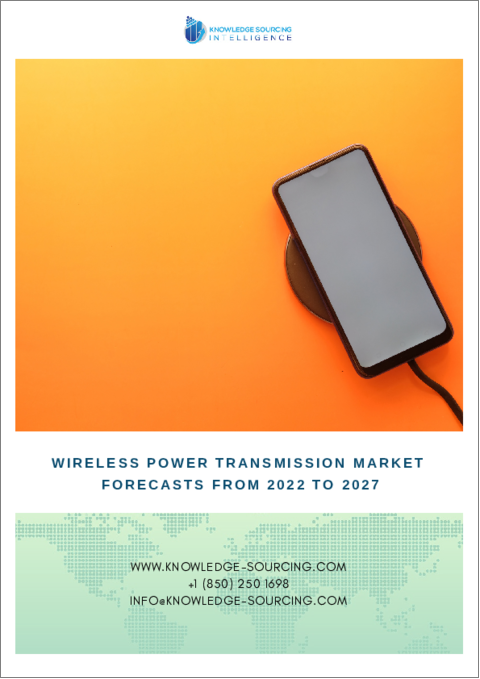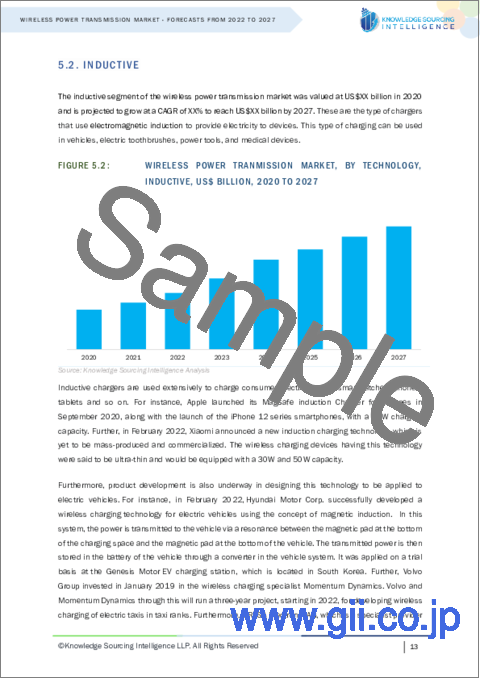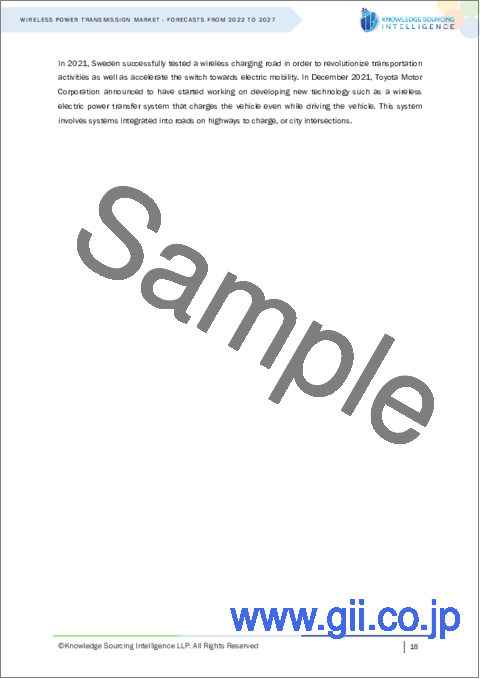|
|
市場調査レポート
商品コード
1171436
ワイヤレス電力伝送の世界市場予測(2022年~2027年)Wireless Power Transmission Market - Forecasts from 2022 to 2027 |
||||||
|
● お客様のご希望に応じて、既存データの加工や未掲載情報(例:国別セグメント)の追加などの対応が可能です。 詳細はお問い合わせください。 |
|||||||
| ワイヤレス電力伝送の世界市場予測(2022年~2027年) |
|
出版日: 2022年11月02日
発行: Knowledge Sourcing Intelligence
ページ情報: 英文 146 Pages
納期: 即日から翌営業日
|
- 全表示
- 概要
- 目次
世界のワイヤレス電力伝送の市場規模は、2020年に101億1,100万米ドルとなり、予測期間中に14.86%のCAGRで成長し、2027年に266億6,300万米ドルになると予測されています。市場を牽引する要因には、人々の可処分所得の増加による、エンターテインメント機器、携帯電話、ノートパソコンなど、最新の技術に基づく機器や家電製品に費やす傾向の強まりなどが挙げられます。また、自動車メーカーが電気自動車の充電にこの技術を搭載することに注力していることも、需要を増加させ、市場の成長をさらに後押しします。
当レポートでは、世界のワイヤレス電力伝送市場について調査し、市場規模や予測、COVID-19の影響、市場の促進要因および課題、市場動向、セグメント別の市場分析、競合情勢、主要企業のプロファイルなどの体系的な情報を提供しています。
目次
第1章 イントロダクション
- 市場概要
- COVID-19の影響
- 市場の定義
- 市場セグメンテーション
第2章 調査手法
- 調査データ
- 前提条件
第3章 エグゼクティブサマリー
- 調査のハイライト
第4章 市場力学
- 市場促進要因
- 市場抑制要因
- ポーターのファイブフォース分析
- 供給企業の交渉力
- 買い手の交渉力
- 新規参入者の脅威
- 代替品の脅威
- 競争企業間の敵対関係
- 業界バリューチェーン分析
第5章 ワイヤレス電力伝送市場分析:コンポーネント別
- イントロダクション
- ハードウェア
- ソフトウェア
第6章 ワイヤレス電力伝送市場分析:技術別
- イントロダクション
- 誘導結合
- 容量結合
- 共振誘導結合
- その他
第7章 ワイヤレス電力伝送市場分析:範囲別
- イントロダクション
- 短
- 中
- 長
第8章 ワイヤレス電力伝送市場分析:用途別
- イントロダクション
- 家電
- ヘルスケア
- 自動車
- その他
第9章 ワイヤレス電力伝送市場分析:地域別
- イントロダクション
- 北米
- 米国
- カナダ
- メキシコ
- 南米
- ブラジル
- アルゼンチン
- その他
- 欧州
- ドイツ
- フランス
- 英国
- スペイン
- イタリア
- その他
- 中東・アフリカ
- サウジアラビア
- イスラエル
- アラブ首長国連邦
- その他
- アジア太平洋地域
- 中国
- 日本
- 韓国
- インド
- インドネシア
- タイ
- 台湾
- その他
第10章 競合環境と分析
- 主要企業と戦略分析
- 新興企業と市場の有利性
- 合併、買収、契約、コラボレーション
- ベンダーの競合マトリックス
第11章 企業プロファイル
- Samsung Electronics Co. Ltd
- WiTricity Corporation
- TDK Corporation
- Murata Manufacturing Co. Ltd
- Energous Corporation
- Texas Instruments Incorporated
- Renesas Electronics Corporation
- LG INNOTEK
- Qualcomm Technologies, Inc.
- RRC power solutions
The global wireless power transmission market is projected to grow at a CAGR of 14.86% to reach US$26.663 billion by 2027, from US$10.111 billion in 2020. Wireless Power Transmission (WPT), also known as wireless energy transmission, is defined as the seamless transmission of electrical energy without the use of wires. In this system, a transmitting device is powered by an electric source and generates a time-varying electromagnetic field that is used to transfer power across space to a receiving device. This receiver extracts the power and delivers it to the load. This technology improves mobility, and convenience, and eliminates the need for wires and batteries. People's disposable income is increasing, which increases their proclivity to spend on the latest technology-based devices and consumer electronics such as entertainment devices, mobile phones, and laptops, pushing the demand for wireless power transmission systems and thus boosting market growth. Moreover, the increasing requirement for more reliable and efficient energy distribution systems and lines is encouraging electric grid operators to look for a solution like smart grids, which include smart metres, appliances, and renewable resources, will assist them in managing energy resources more effectively and efficiently. This will increase the demand for wireless power transmission systems and drive the market growth over the forecast period. In addition, the increasing focus of automakers to include this technology for the charging of electric vehicles will also increase demand and bolster the market's growth further.
Furthermore, rising investments and participation from market players to improve these machines by incorporating advanced features and encouraging their use in a variety of applications will drive market growth over the forecast period. For instance, on 22nd May 2019, Samsung announced the launch of two new products in its wireless device portfolio called the Wireless Power Bank and Wireless Charging Duo Pad. These new devices will encourage a connected lifestyle and can charge any Qi-certified device.
The wireless power transmission market has been segmented based on components, technology, range, application, and geography. By component, the market has been divided into two parts: hardware and software. By technology, the market has been divided into several segments, including inductive coupling, capacitive coupling, resonant inductive coupling, and others. The market has been divided into three ranges: short, medium, and long. The market has been divided into applications such as consumer electronics, healthcare, automotive, and others.
The hardware segment holds a sizable market share.
The hardware segment is expected to account for a significant market share due to the affordability of these solutions for consumers, which is easily met by their desire to purchase upgraded technology and increased spending on advanced consumer electronics. Inductive coupling is estimated to hold the majority market share, owing to the fact that this type of technology is regularly used for most of the modern applications we see today, such as wireless room entry key cards, wireless toothbrush charging stands, and wireless docks for phones that facilitate charging.
Medium and long-range will have a sizable market share.
By range, the medium and long-range segments account for a significant market share because most of the applications that wireless power transmission caters to require a good range for a more effective and efficient transfer of power with no losses or delays.
By application, consumer electronics is expected to have a significant market share because all recently launched and upcoming consumer electronics support wireless power transmission capabilities, making them more advanced and efficient. Furthermore, Automotive has the potential to increase its share over the forecast period as a result of middle-class investments in research to improve the wireless charging capability of electric vehicles and make it more efficient.
Geographically, Asia Pacific holds the majority share because China is the major consumer electronics manufacturing hub. The growing demand for consumer electronics and advanced electronic devices from an expanding middle-class population, combined with mini-robot research and development, will contribute to this growth.
Recent Developments
- Neotes Co., Ltd. announced in December 2021 that it had succeeded in developing a completely new wireless power transmission technology that overcomes all of the various obstacles that have been major issues with the conventional wireless transfer.
- Ericsson and PowerLight demonstrated the world's first wirelessly powered 5G base station in October 2021. The achievement is part of the two companies' collaboration to explore and develop innovative 5G solutions aimed at increasing the speed and flexibility of network deployment in a variety of environments.
- EEMROD, a New Zealand-based technology startup, announced in September 2020 that it had developed new long-range, high-powered wireless power transmission technology that could replace existing copper lines.
COVID-19 impact on Wireless Power Transmission Market
COVID-19 had a negative impact on the wireless power transmission market due to the strict lockdowns and social distancing implemented to contain the virus's spread. Economic uncertainty, a partial business shutdown, and low consumer confidence all impacted demand for wireless power transmission technology. During the pandemic, the supply chain and logistics activities were hampered. However, due to the relaxation of restrictions, the wireless power transmission market is expected to pick up steam in the post-pandemic scenario.
Segmentation
The global wireless power transmission market is segmented by component, technology, range, application, and geography.
- By Component
Hardware
Software
- By Technology
Inductive Coupling
Capacitive Coupling
Resonant Inductive Coupling
Others
- By Range
Short
Medium
Long
- By Application
Consumer Electronics
Healthcare
Automotive
Others
- By Geography
North America
- USA
- Canada
- Mexico
South America
- Brazil
- Argentina
- Others
Europe
- Germany
- France
- United Kingdom
- Spain
- Others
Middle East and Africa
- Saudi Arabia
- Israel
- UAE
- Others
Asia Pacific
- China
- Japan
- South Korea
- India
- Others
TABLE OF CONTENTS
1. Introduction
- 1.1. Market Overview
- 1.2. Covid-19 Scenario
- 1.3. Market Definition
- 1.4. Market Segmentation
2. Research Methodology
- 2.1. Research Data
- 2.2. Assumptions
3. Executive Summary
- 3.1. Research Highlights
4. Market Dynamics
- 4.1. Market Drivers
- 4.2. Market Restraints
- 4.3. Porter's Five Forces Analysis
- 4.3.1. Bargaining Power of Suppliers
- 4.3.2. Bargaining Power of Buyers
- 4.3.3. Threat of New Entrants
- 4.3.4. Threat of Substitutes
- 4.3.5. Competitive Rivalry in the Industry
- 4.4. Industry Value Chain Analysis
5. Wireless Power Transmission Market Analysis, By Component
- 5.1. Introduction
- 5.2. Hardware
- 5.3. Software
6. Wireless Power Transmission Market Analysis, By Technology
- 6.1. Introduction
- 6.2. Inductive Coupling
- 6.3. Capacitive Coupling
- 6.4. Resonant Inductive Coupling
- 6.5. Others
7. Wireless Power Transmission Market Analysis, By Range
- 7.1. Introduction
- 7.2. Short
- 7.3. Medium
- 7.4. Long
8. Wireless Power Transmission Market Analysis, By Application
- 8.1. Introduction
- 8.2. Consumer Electronics
- 8.3. Healthcare
- 8.4. Automotive
- 8.5. Others
9. Wireless Power Transmission Market Analysis, By Geography
- 9.1. Introduction
- 9.2. North America
- 9.2.1. USA
- 9.2.2. Canada
- 9.2.3. Mexico
- 9.3. South America
- 9.3.1. Brazil
- 9.3.2. Argentina
- 9.3.3. Others
- 9.4. Europe
- 9.4.1. Germany
- 9.4.2. France
- 9.4.3. United Kingdom
- 9.4.4. Spain
- 9.4.5. Italy
- 9.4.6. Others
- 9.5. Middle East and Africa
- 9.5.1. Saudi Arabia
- 9.5.2. Israel
- 9.5.3. UAE
- 9.5.4. Others
- 9.6. Asia Pacific
- 9.6.1. China
- 9.6.2. Japan
- 9.6.3. South Korea
- 9.6.4. India
- 9.6.5. Indonesia
- 9.6.6. Thailand
- 9.6.7. Taiwan
- 9.6.8. Others
10. Competitive Environment and Analysis
- 10.1. Major Players and Strategy Analysis
- 10.2. Emerging Players and Market Lucrativeness
- 10.3. Mergers, Acquisitions, Agreements, and Collaborations
- 10.4. Vendor Competitiveness Matrix
11. Company Profiles
- 11.1. Samsung Electronics Co. Ltd
- 11.2. WiTricity Corporation
- 11.3. TDK Corporation
- 11.4. Murata Manufacturing Co. Ltd
- 11.5. Energous Corporation
- 11.6. Texas Instruments Incorporated
- 11.7. Renesas Electronics Corporation
- 11.8. LG INNOTEK
- 11.9. Qualcomm Technologies, Inc.
- 11.10. RRC power solutions




